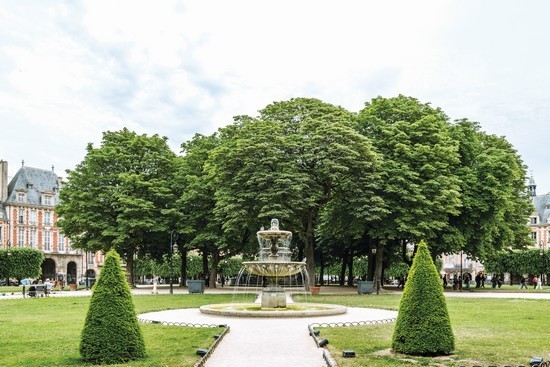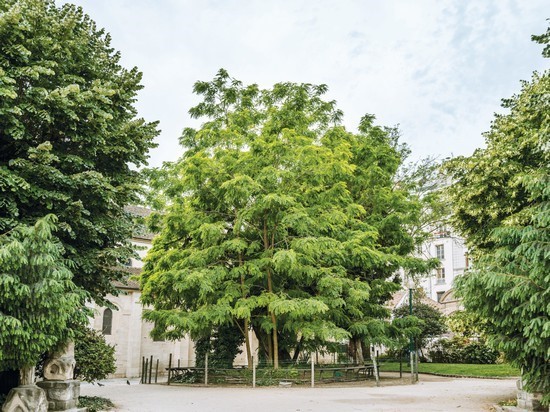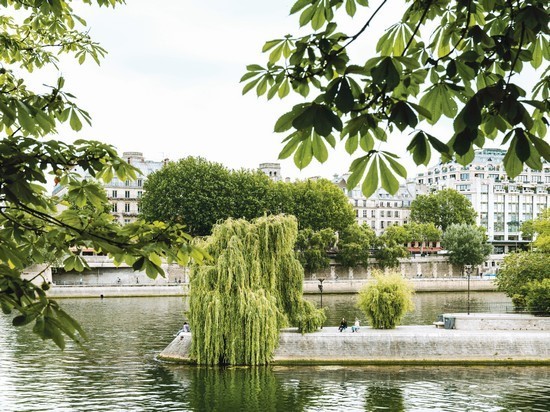As a
Paris resident, I scarcely paid attention to the city’s treescape until a few
years ago, when I stumbled upon an arresting scene of a young man stretched out
in the elbow of a low-lying branch of a Japanese pagoda tree, its leaves
skimming the pond at Buttes-Chaumont Park in the 19th arrondissement.
اضافة اعلان
From that moment,
I came to understand that the city’s trees — from the dramatic weeping willows
and their trailing fronds along the Seine to the military rows of London plane
trees that line the
Champs-Élysées — play an underappreciated supporting role
in Paris’ inimitable elegance and grandeur.
It was a belated
epiphany, and one that is somewhat understandable: Urban trees can be overlooked,
particularly in Paris, where dozens of stately landmarks command the attention
of locals and visitors alike.
But public and
political awareness of the city’s trees has renewed recently, not only as
natural, free-standing monuments equal in importance to the Louvre or the
Eiffel Tower but also as key assets in the fight against climate change. City
lawmakers, arborists, and others in Paris are investing in the treescape by
planning new urban forests, increasing the number of protected historical trees,
and designing walking tours — because trees can also offer a fresh,
green-minded perspective of the City of Light.

“Trees are an
important part of Paris’ identity,” said Christophe Najdovski, the deputy mayor
in charge of greenspace. “The alignment of trees and Parisian promenades
structure the city enormously and is a 150-year-old heritage. We’re following
in the footsteps of this heritage.”
Remarkable trees
As it turns out, the Japanese pagoda tree (which has since been fenced
off) is one of 15 in Paris that carries the official designation “Remarkable
Tree of France” from Arbres, a volunteer association made up of some of the
country’s most eminent scientists, botanists, gardeners, writers, and
horticulturalists. The association aims to promote and protect the most
beautiful, important and rare trees in France with a formal label.
Also on the list:
a 420-year-old tree that is not particularly striking but has extraordinary
cultural and biological significance.
Brought over from
North America and planted in 1601 in the small Square Réné Viviani, across the
street from the
Notre Dame Cathedral, the black locust, or Robinier faux
acacia, is the oldest tree in Paris. Its foliage still blooms green and full,
but the tree bears scars from bombing and shelling during World War II, and its
splintering trunk is supported by steel beams.
“She is the mother
plant,” Béatrice Rizzo, a city forest engineer, explained to me during a guided
visit. “You could say that all the black locust trees in France came from this
one tree.”

In addition to
the Arbres list, which can be found online, the city of Paris keeps a separate,
more expansive catalog of remarkable trees — all 176 are plotted on a public
interactive map. Both lists share similar criteria that include age, size, and
botanical and cultural importance.
The black locust
at Square Réné Viviani carries the Remarkable designation from both the city of
Paris and Arbres, and is the last of six stops on a self-guided walking tour of
trees created by the city.
“A damaged tree
like this would never have survived in nature,” said Georges Feterman, Arbres
president. “It’s like protecting monuments. Why do we preserve old churches?
Because they testify to the history of men.”
Other tree
landmarks on the city’s walking tour include the orderly formation of linden
trees that border the Place des Vosges square and flood-resistant poplars at
Place Louis Aragon on Île-Saint-Louis.
Long heritage of urban planners
Last year, Paris lawmakers approved a project that aims to plant 170,000
new trees throughout the city by 2026, and create pockets of urban forests in
strategic areas to mitigate the effects of extreme urban heat and soak up air
pollution. The city also released a 10-point “tree charter” that includes a
pledge to protect Paris’ exceptional specimens.

“The goal is to
completely review the urban approach, protect existing trees and plant as much
as we can in six years,” Najdovski said.
“The alignment of trees along avenues and main
boulevards are mostly monospecific trees, often either the London plane or the
horse chestnut tree, which creates a repetitive landscape,” said Avila Tourny,
the city’s lead urban architect. “The effect is a monumental perspective, a bit
like Versailles. And in the heart of Paris, it creates a very classic
landscape.”
In recent years,
Rizzo, the forest engineer, said, the climate emergency has also made Parisians
more attached to their city’s trees. When tapping the trunks with wooden
mallets to listen for illness, she will be stopped by concerned passers-by and
has to reassure them that she’s simply conducting a “medical visit.”
“The tree has
never been as front and center as the savior of the planet and our well-being
in the city as it is today,” she said. “I’ve been doing this job for 30 years,
and I’ve never spoken so much about trees.”
Indeed, news that
a 200-year-old
London plane tree near the Eiffel Tower could be torn down as
part of the city’s plans to renovate the area for the Olympic Games in 2024
drew protests and ignited online outrage for weeks this spring. When asked
about the fate of the tree, Najdovski said the city is reexamining the plans
and that “zero trees” will be felled during construction.
Read more Travel
Jordan News



